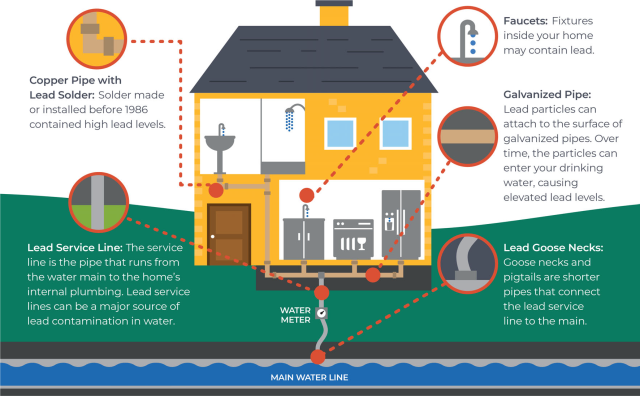Lead and Copper Information
Is Lead in Your Plumbing?
Today, there’s growing awareness that some homes have lead in water pipes, fixtures and plumbing. Lead presents health concerns for people of all ages, particularly pregnant women, infants and young children. In children, low exposure levels have been linked to learning disabilities, behavioral problems and other issues.
Where Water Meets Lead
The water leaving the treatment plant and traveling through water mains is almost always free of lead. However, lead is sometimes present in the service lines connecting older homes to the water system, or in fixtures and home plumbing. All of our water mains and fixtures up to the customer owned service lines are lead free. Our utility adjusts the water’s chemistry at the treatment plant to minimize the possibility of lead dissolving into the water, but there are additional steps you can take at home.


What You Can Do
1.) Have your water tested.
You can contact a certified laboratory to have your water tested for lead. A listing is available at https://mytapscore.com/products/lead-and-copper-water-test
We are not affiliated with the vendors of this test in any way.
2.) Find out if you have a lead service line.
Here in Blount County, lead service lines are mostly in homes constructed before 1986. You may be able to determine on your own if yours is made of lead. Service lines typically enter the home in the basement or crawl space. If the pipe is lead, it will have a dull finish that shines brightly when scratched with a key or coin. Using a magnet can also help you identify a lead pipe. Even a strong magnet will not cling to lead.
3.) Have your plumbing inspected
A licensed plumber can inspect both your service line and other materials that come in contact with your drinking water. Lead solders, pipe fittings and brass fixtures can be potential problems.
Protect your Household
There are steps you can take right away to reduce the possibility of lead in your water:
• Run the Tap Before Use – Lead levels are likely at their highest when water has been sitting in the pipe for several hours. Clear this water from your pipes by running the cold water for several minutes, which allows you to draw fresh water from the water main. You can use this water on house plants or to flush toilets.
• Clean Aerators – Aerators are small attachments at the tips of faucets which regulate the flow of water. They can collect small particles of lead in their screens. It’s a good idea to remove your aerators at least monthly and clean them out.
• Use Cold Water for Drinking and Cooking – Always cook and prepare baby formula with cold water, because hot water dissolves lead more quickly, resulting in higher levels in water.
• Filter the Water – Many home water filters are effective at removing lead. If you purchase a filter, make sure it is certified for lead removal and that you maintain it properly. Find out more on filter certification at www.nsf.org.
Let's Get the Lead Out!
The surest way to protect against lead in water is to get the lead out altogether.
• Replace Lead Service Lines
If you have a lead service line, talk to a licensed plumber about getting it replaced.
• Replace Other Plumbing That Contains Lead
We recommend you use an experienced, certified plumber to look for and replace lead fittings, fixtures or other potential sources of lead.

